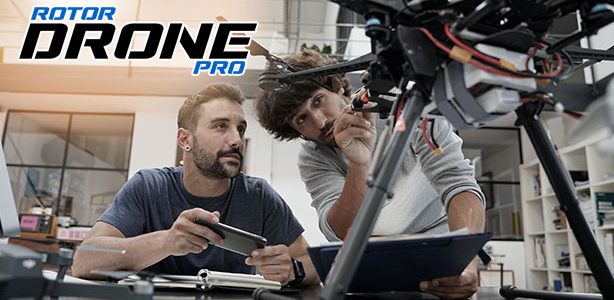It isn’t every year that an entirely new mode of flight is developed—but when it is, it seems that uncrewed aircraft systems (UAS) are the preferred venue, likely because new concepts can be tested at significantly less cost and risk than the alternative.
One such example was on display at the Association for Uncrewed Vehicle Systems International (AUVSI) Xponential show in Orlando, Florida earlier this year: the Aergility Atlis. At first glance, the Atlis appears to be one among a seemingly endless parade of embedded multirotor, hybrid gas/electric VTOLs developed for cargo delivery on display at the show every year.
Look more closely, however, and there are clues that something special is happening here: the wings are too thin and stubby to provide enough lift for an aircraft of this size, they lack ailerons, and the multirotor propellers seem over-size, even given the bulk of the airframe. What is going on here?
That is the question I put to Brian Vander Mey, Aergility’s director of sales and marketing.
“It’s a union of two different flight technologies,” he explained. “You have a multirotor that is used for vertical takeoff and landing—but then it essentially operates as an autogyro in forward flight.”
For those of you who need a little refresher, a typical crewed autogyro is a small, lightweight flying machine that broadly resembles a helicopter—in that it doesn’t have fixed wings and is held aloft by a spinning rotor overhead—with a pusher prop at the back.
Autogyros have appeared occasionally in the cinema over the years: such as “Little Nellie” in the James Bond classic “You Only Live Twice,” starring Sean Connery, as well as the seminal post-apocalyptic masterpiece “The Road Warrior,” which sees an autogyro flown by an eccentric aviator played by Bruce Spence.
While it may look like a helicopter, an autogyro actually shares much more in common with a fixed-wing aircraft when it comes to performance. The overhead rotor turns freely and is not connected to the aircraft’s engine. The propeller at the rear produces thrust, causing the main rotor to turn as air passes through it—thereby generating lift. Consequently, autogyros must maintain a minimum forward airspeed to sustain flight and cannot take off or land vertically.
Of course, the Atlis can ascend and descend vertically by spinning up the propellers that turn freely in forward flight using electric motors. Furthermore, that same ability to power the lift propellers in flight creates an entirely new means of controlling the aircraft.
“We call this approach ‘managed autorotation.’ If we need to bank to the right, for example, we would add power to the propeller on the right side of the aircraft,” said Vander Mey. “However, we would also generate power from the propeller on the left side of the aircraft, so that the net energy cost is zero.”
So that explains the lack of ailerons. What about those comically undersized wings: what do they bring to the party?
“The auto-rotation mode provides about 50 percent of the lift and the wing provides the other 50 percent,” Vander Mey explained.
The platform is capable of transporting 400 to 600 pounds of cargo up to 600 miles in its 40-cubic-foot bay. Converting that bay into a fuel tank provides the Atlis with a maximum ferry range of 1,600 miles. The aircraft’s cruising speed is 100 miles per hour.
While Vander Mey anticipates strong interest from the military in the platform’s capabilities, he sees even more applications among civilian users. “This could be very useful for transporting supplies to off-shore oil and gas platforms, as well as mines that are located in remote areas. We’ve been talking to several companies in Australia about that,” he said. “Also, take a look at Puerto Rico after Hurricane Maria hit: bridges were washed out, so even if you could get supplies to the port on the coast, it was extremely difficult to move them inland.”
As another example, he cites developing countries in Africa, where there are 200,000 villages that are difficult to access using cars and trucks.
“People talk a lot these days about last-mile deliveries, but to make a last-mile delivery, you actually need to get your item within a mile of the person who needs it,” Vander Mey said. “We think of this as a last 100-mile solution.”
TEXT & PHOTOS BY PATRICK SHERMAN



















